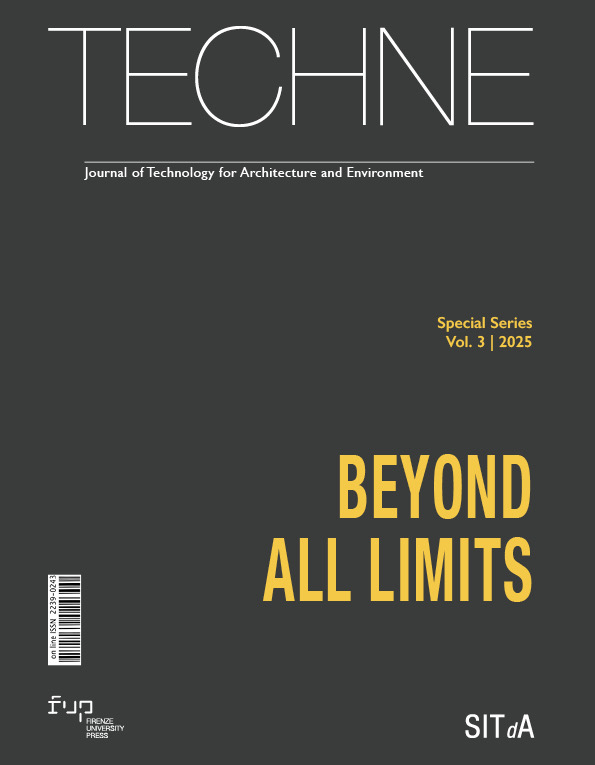Published 2025-07-31
Keywords
- Balanced design,
- User-Centred design,
- Recycled materials,
- Modular flexibility,
- Adaptability
How to Cite
Copyright (c) 2025 Marica Merola

This work is licensed under a Creative Commons Attribution 4.0 International License.
Abstract
The objective of the research is to study innovative architectural solutions that improve the quality of life in urban environments by integrating natural elements into existing housing systems. The object of the study is requalification of the Grupo de Viviendas Antonio Rueda in Valencia with the aim of creating flexible and modular living spaces that adapt to evolving user needs while promoting a symbiotic relationship between residents and the environment. The project goes beyond sustainability and environmental quality improvement by actively engaging user-centred design methodologies to identify the preferences and needs of the inhabitants. This participatory approach ensures that the proposed solutions are not only sustainable but also socially inclusive and functional. The integration of modular and flexible design strategies allows for the evaluation of different spatial configurations and material applications, assessing their effectiveness in enhancing comfort and well-being. By utilising natural and recycled materials, the research establishes a framework for a balanced design approach that strengthens human-nature connections while improving the resilience and liveability of urban housing environments.
Downloads
References
- Augé, M. (1995), Non-places: an Introduction to Supermodernity, London: Verso.
- Di Perna, C., Di Loreto, S. (2022), “La valutazione tecnica della sostenibilità ambientale”, II comfort sostenibile. Le dinamiche ambientali in edilizia, finanza, tecnologia e cultura, Maggioli Editore. ISBN: 8891661031
- Fundación Docomomo Ibérico. (2025). Grupo de viviendas Antonio Rueda – Fundación Docomomo Ibérico. Available at: https://docomomoiberico.com/edificios/grupo-de-viviendas-antonio-rueda [Accessed on 10/08/2024]
- Guajardo, A. (2017), “Análisis tipológico de bloques lineales de vivienda social: España 1950-1983. El caso de Andalucía occidental”, Informes De La Construcción, 69(545), p. e185. https://doi.org/10.3989/ic.16.055. DOI: https://doi.org/10.3989/ic.16.055
- Lyotard, J. F. (1984), The postmodern condition: A report on knowledge (vol. 10), Manchester: Manchester University Press. DOI: https://doi.org/10.2307/1772278
- Marini, A. (2016), “Il territorio è la casa dell’uomo: il progetto umano da habitat ad eu-topia”, Sguardi tra i residui. I luoghi dell’abbandono tra rovine, utopie ed eterotopie, Mimesis, p. 31-44.
- Olgyay, V. (1981), Progettare con il clima, un approccio bioclimatico al regionalismo architettonico”, Padova: Franco Muzzio Editore, (ed. originale 1963).
- Roa-Fernández, J., Galán-Marín, C., Rivera-Gómez, C. and Palomares-Figueres, M.T. (2022), “Methodology for the characterization of building envelope: Virgen del Carmen Group at Valencia”, Proceedings – 3rd Valencia International Biennial of Research in Architecture, VIBRArch. doi:https://doi.org/10.4995/vibrarch2022.2022.15197 DOI: https://doi.org/10.4995/VIBRArch2022.2022.15197
- Romano, R., Di Monte, E. and Sore, A. (2024), “New perspectives and moving targets to improve biodiversity and urban resilience”, TECHNE – Journal of Technology for Architecture and Environment, (27), pp.151–166. https://doi.org/10.36253/techne-15132. DOI: https://doi.org/10.36253/techne-15132
- Sciortino, L. (2020), “Difesa del ‘Genius Loci’”, Prospettiva Ponte e Genius Loci, Mimesis Edizioni p. 719-731.
- Violano, A. and Cannaviello, M. (2022), “Design process innovation through flexible and circular technological solutions,” VITRUVIO – International Journal of Architectural Technology and Sustainability, 7(2), pp. 60–73. https://doi.org/10.4995/vitruvio-ijats.2022.18715. DOI: https://doi.org/10.4995/vitruvioijats.2022.18715
- Violano, A. and Cannaviello, M. (2023), “The carbon footprint of thermal insulation: the added value of circular models using recycled textile waste”, Energies, 16(19), p. 6768. https://doi.org/10.3390/en16196768. DOI: https://doi.org/10.3390/en16196768
- Violano, A. and Harputlugil, T. (2024), “Water and Carbon Neutral Buildings: systemic approaches and hybrid strategies”, IOP Conference Series Earth and Environmental Science, 1402(1), p. 012053. https://doi.org/10.1088/1755-1315/1402/1/012053. DOI: https://doi.org/10.1088/1755-1315/1402/1/012053






